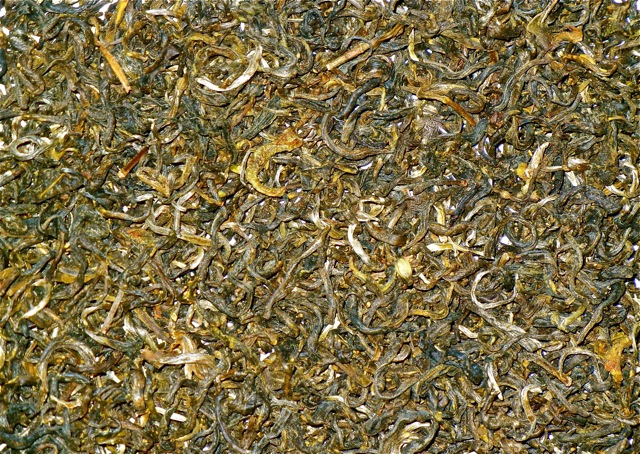A little recollection of being introduced to Bang Ma tea; it contentedly remains a tea by my side on every journey since discovering it.
There are moments that hit when the head and heart – and in this particular case the taste buds – gel in union, deciding to agree…even if just for the moment.
My little sitting spot perched on an uneven log seems a rather simple place for this cerebral ‘coming together’, but one cannot plan nor prepare for these moments. A tea table, long stained from decades of daily ritual to the green leaf, sits lower still. Glass cups litter the surface of the table in a random kind of homage to the moment, the time and of course to the tea.
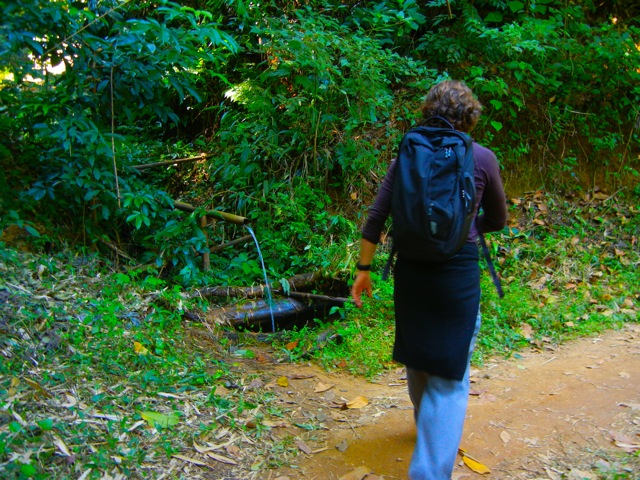
The back of me with tea somewhere in the distance beckoning. Along the route through the Nannuo Mountains
Our room is a centre point of the small elevated house and everything has the narcotic aroma of wet wood. If the tea is exulted then surely our little tea table is a very under-whelming altar, but that is exactly how it should be.
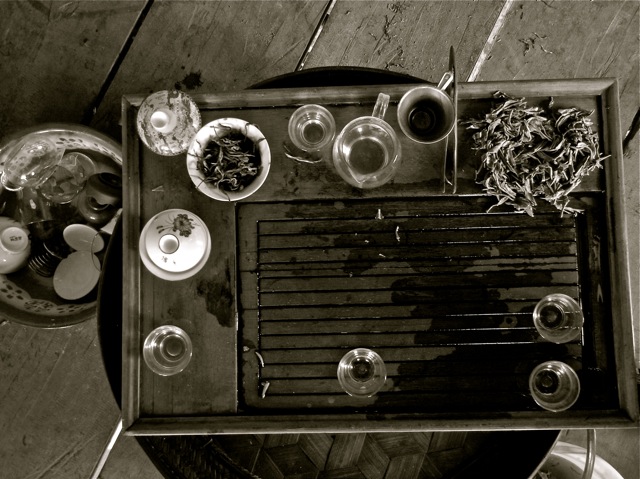
The little tea table that was our 'base of operations' for what would be four hours of tea drinking and culminated in a formidable tea buzz
I along with five others hunch in various positions, pitched forward with unblinking eyes intent on a ceremony we’ve all seen countless times before. Cups, tea leaves by the handful, a flared serving cup (gai bei) and the restless legs of dedicated tea drinkers all surround the little table. It has been this way for hours but suddenly the intensity level has been notched up just as the happy chatter is turned down. Everything has changed with a serving of a tea of particular qualities that even now stamp their authority on the proceedings with something undeniable. This moment of silence has been brought on by sip. It is the kind of sip that arrests things in mid motion and cuts conversations into ribbons. The sip and what it has taken into the mouth has brought clarity, or perhaps reminded us that there are still teas that can do this.
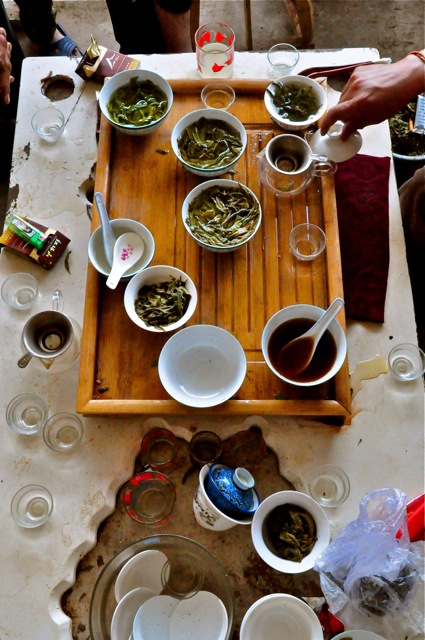
Another tea table in the same town littered with all of the necessities. Cups, bowls...what is missing from view is the thirst
Tea matron Lu keeps a degree of decency in the small simple room – her brightly coloured nails seem at once kitsch and ridiculous within our surroundings, but she has managed to keep tea flowing for the past hours – through lunch – and no one is even remotely interested in interrupting her. Her ritual has been the same up until now, but with more chatter issuing from her. Now, she too has buttoned up. The only sounds she makes is the introduction of a new tea. Here in these tea stained lands people are judged by their tea or the tea they serve. Recollecting the moment, it was only the second time I had ever met Lu and the first time to try this Bang Ma, a tea that would become a staple in my days and remains still.
My own ‘moment’ of silence upon trying the Bang ma seems a collective moment, for everyone who sits with me or around me has been silenced as well. We’ve just been given our first shot of a Spring 2009 Bang Ma green Puerh and it is a sip which has somehow sealed the room in a kind of vacuum. Chatter has ebbed, eyes have refocused and Lu’s eyes just briefly gaze up as though she has deliberately created the moment and knows exactly the response.
The room, my tea cup, Lu, myself and the Bang Ma tea are all within a home west of Jinghong in Xishuangbanna, deep in southern Yunnan, and around us a vault of silent green insulates our proceedings. South of the main road that passes the acclaimed Nannuo Mountains – of tea fame – we have taken narrow cement road that doesn’t belong on a mountain up through a series of switchbacks. Then we walk and we walk.
Nannuo Mountain is a loose green range of mountains rather than one simple mound. Within its holdings there are many little towns that grow tea, and deep within Bang Ma is one. It is rare to find fermented, ‘cooked’ black Puerhs in the regions that grow so much of the classic big leafed ‘assamica’. Here teas are plucked, withered, fried and dried…and then of course consumed, though many will say that a good local ‘unfermented’ (sheng) Puerh it is at its optimal ‘taste stage’ when it is around 1-2 years ‘old’ (picked and created). This though would come with a caveat, as I’ve often heard from local drinkers “Good teas are good teas”.
Around our little shack cicadas run their mantras high in the trees and there are the squawks of the cavernous forests around. Soft humid mist remains and dilutes everything to mushy outlines even now in the early hours of afternoon. Outlines at this point don’t matter as for the very vital ‘now’ what is transfixing is the Bang Ma tea we sip. Coming to the source means guaranteeing you drink of the tea that is grown at the source. The source here in the mountains is that great green landscape outside around us. Within it lie entire forests of ancient tea trees with leaves as large as feet, and branches as thick as arms. Where we sit….only kilometres from Bang Ma near the great forests the tea trees are close brethren, but the centuries old tea trees fortunes have mirrored the villages’, and the ‘fortunes’ relatively speaking have been good. Within the mountains strongholds of ‘good tea mountains’ teas are now purchased in bulk and contribute a significant portion of income to the families.

A tea 'station' deep within Nannuo Mountain near Bang Ma. Thatched huts provide shelter and storage areas for tea harvesters who are working a particular area. The leaves must be sheltered from the sun
Our group is made up of three locals, myself, Lu and another tea-starved friend from further west in Yunnan. This tea session has taken in four teas thus far, all green pungent Puerhs from small towns around where we sit, all with their own qualities and ‘highs’; but with this new Bang Ma something has changed.
The tea has managed – in two brief cups – to cut through the tongues layers and infuse the entire mouth with itself – wiping away all predecessors with strength and a long hit of subtle vegetals that also cut through the previous teas. With many teas (and very much depending on where one has purchased it from) a name means nothing as the tea one sips may be from four or five different areas ‘not’ even within the town or region that is purportedly named after.

Though the leaves and flavour are pure green a concentrated cup of Bang Ma comes out dark apricot in colour and leaves a potent impression
This Bang Ma that has us entranced is entirely local and of the earth – picked, harvested, ‘created’ entirely within sight of the town. With Lu there has never been a question of a tea’s authenticity. More often the question is where to get more of it. I have been told more than once though that some tea companies claim their teas are from Nannuo or a specific town or region, go so far as to print and advertise their teas as being such, without not so much as a company person having ever stepped foot in an area. It is one of the ugly but inevitable aspects of the tea world. In villages in this area there are ‘watchmen’ who keep eyes upon all visitors and vehicles making their way into the folds of tea-land.

Getting to the tea mountains required a few necessary stops to savour local delicacies like these fresh water fish from the Dai minority - who also have their own ancient history with tea
They care not so much about what is brought in but rather what is taken out. Not just anyone can saunter in and by up a huge amount of tea. You visit with a friend who knows someone local. In this way teas, methods and integrity are kept (or at least attempted to be kept). When we arrived to the town we stepped through an ancient bamboo gate with silver foil and prehistoric looking carved animals – part of the animistic legacy here – and just beyond the gate two villagers watched quietly before warmly greeting Lu and the three locals.
This Bang Ma tea moment that we are happily lodged in at the moment isn’t overwhelmed by anything but the tea and that is the point. Nothing other than cups, leaves and lips are required. Lu’s ornately painted nails are about the most extravagant thing within kilometres as she prepares yet another much desired round of Bang Ma.
As we slurp back a third and fourth cup, the silence loosens its grip but only slightly. Every sip reinforces the quality of the tea. It is strong and almost forceful but even though astringent, with every waft, sip and tingle there is flavour and it finishes having put a stamp of authority upon the entire mouth and throat. It has the strength to push aside our previous hours of teas and make an impact that brings up the level of enjoyment a first cup does. It is hard what to make of a tea like this of its sheer impact. Either the previous teas – which were good – are not in fact good; or that this tea is simply in another league.
Being gentle skeptics as opposed to reckless ones, all of us decide that this tea is simply in another league. It is at this point that Lu speaks in her particular quick-tongued way that the Bang Ma is higher in sugar content than many teas – the leaves themselves – and that this blends well with the strength and purity of the product creating a lasting flavour. For locals (within southern Yunnan’s tea hubs) Bang Ma is a classic and spring editions are sought after and costly.
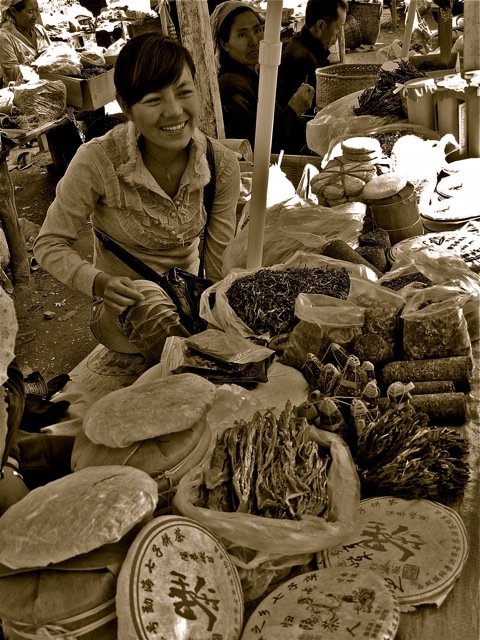
Many informal tea stalls line the road between Jinghong and Menghai selling very local teas from the source. Often great deals are to be had with the added bonus of interaction with locals, keeping the proceedings spontaneous. If one wants to sample, you often have to visit the home of the vendor
Simply prying this tea from so deep within Nannuo Mountain’s cavities is a feat; up until recently it required day-long journeys by foot lugging tea to a roadway and then transported on into tea centres. Just arriving here our group had the previous day driven from Jinghong through three indigenous strongholds – all who have tea culture (and significant amounts of tea itself) running through its blood – walked along warm mountain paths, driven again and finally walked into this little town…and we’re still not in Bang Ma – but, we have indulged in its tea.

The slow speed of life continues into dusk in southern Yunnan when talk and business of tea settles down
One of the local men, who is our co-our host and in who’s home we now sit, exhales loudly in an almost resigned way. Though he is not from Bang Ma he also creates teas (one of which we have tried today) but the name of the tea (for now at least) will never have the impact of the Bang Ma. This bit of knowledge has only just come out and there is a gentle bit of embarrassed fidgeting from all of us knowing this. But, he appears oblivious to his own tea’s underwhelming performance against the heralded Bang Ma.
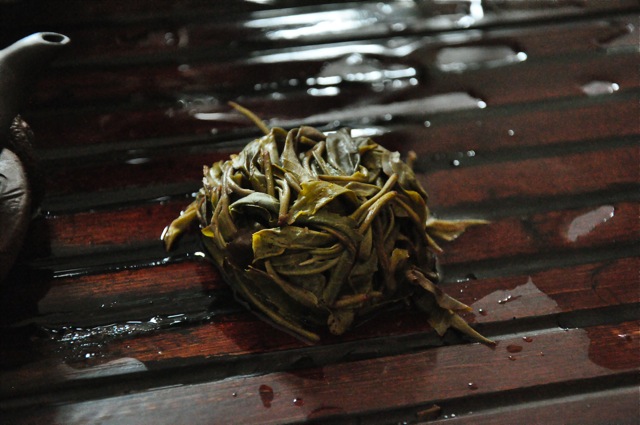
Still magnificent even in their sodden 'afterlife' the Bang Ma leaves make way for a newer batch of leaves
He tells us in a soft voice that even among the Hani people’s tea strongholds, Bang Ma is a special tea. When pushed as to why it ranks so highly he responds simply saying that “Bang Ma has traditionally been isolated so their methods and product has remained unchanged by the tea markets up until very recently. They start with great soil, drainage and ancient tea trees and keep it simple. They didn’t get caught up in trends and their ancient trees (gu shu) are some of the most coveted.”
In these areas; areas that for me sum up all that is good in tea culture and consumption, it seems always to come down to this green version of simple. Earth, attention to detail and a great ‘base’ product cannot be denied. Wrapping, plaudits, apparent quality and gimmicks are usually (but not always) laid bare when it comes to the sip.
At this point he takes a flared tea cup and dumps the used Bang Ma tea remnants onto the table nimbly picking up leaves with his large fingers and studying the leaves’ pliancy, the stems, everything… “You see the leaves? Nubile and young”. The young end buds (usually seen as white curled leaves within dry leaves) are laden with all of tea’s wonder-chemistry and contribute those light hints and subtle flavours while the bigger leaves give the tea an anchor of strength (or in many cases no anchor at all).
Strolling outside later on, for what was to be a very brief break from our liquid friend, the insipient humid mists seem to have been swept out of the little town by drafts coming from the west. The wet forests around us seem to inhale deep from the air currents. Green silent walls with ancient tea trees sewn in, the entire area seems to watch from its dark perspective with a kind of calm. The indigenous Hani dwellers who have long been entrusted to geographies of tea also seem to keep their lives simple. Hens rush around for errant bugs and corn kernels, lean and patient sly-eyed dogs lie languidly and the thatched huts all appear content with their lot in life. The dark complexions of the locals, their glowering eyes and their neat movements speak of that enviable mix of understanding one’s environment and using it to create a masterpiece.
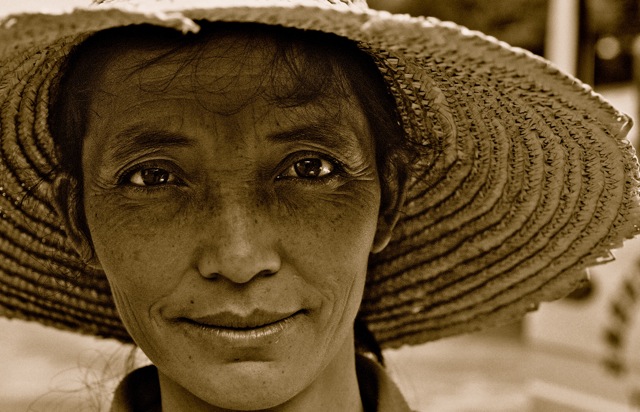
One of the many faces relating to the south of Yunnan, where indigenous culture is inseparable from tea culture
Lu walks past me in a tiny centre square of the village and tells me to be next door – another local home – in fifteen minutes for more tea.


